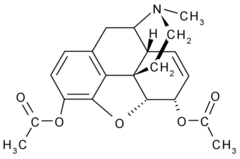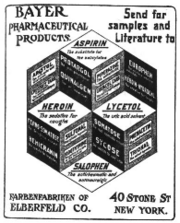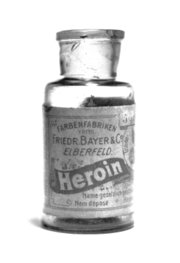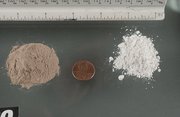Heroin
Heroin or diacetylmorphine (INN) is a semi-synthetic opioid. It is the 3,6-diacetyl derivative of morphine (hence diacetylmorphine) and is synthesised from it by acetylation. The white crystalline form is commonly the hydrochloride salt, diacetylmorphine hydrochloride. It is highly addictive when compared to other substances, although occasional use without symptoms of withdrawal has been noted. Heroin is controlled under Schedules I and IV of the Single Convention on Narcotic Drugs. more...
It is not legal to manufacture, possess, or sell heroin in the United States, but diamorphine (heroin) is a legal prescription drug in the United Kingdom. A few of the popular street names for heroin include dope, junk, smack and H.
History
Heroin was first synthesized in 1874 by C.R. Alder Wright, a British chemist working at St. Mary's Hospital Medical School, London. He had been experimenting with combining morphine with various acids. He boiled anhydrous morphine alkaloid with acetic anhydride over a stove for several hours and produced a more potent, acetylated form of morphine. We now call it diacetylmorphine. The compound was sent to F.M. Pierce of Owens College, Manchester, for analysis. He reported the following to Wright:
- Doses … were subcutaneously injected into young dogs and rabbits … with the following general results … great prostration, fear, and sleepiness speedily following the administration, the eyes being sensitive, and pupils dilated, considerable salivation being produced in dogs, and slight tendency to vomiting in some cases, but no actual emesis. Respiration was at first quickened, but subsequently reduced, and the heart's action was diminished, and rendered irregular. Marked want of coordinating power over the muscular movements, and loss of power in the pelvis and hind limbs, together with a diminution of temperature in the rectum of about 4°(rectal failure)
Heinrich Dreser, of Bayer in Elberfeld, Germany, noticed that diacetylmorphine was more potent than morphine. Bayer registered Heroin (meaning 'heroic treatment' from the German word heroisch) as a trademark. From 1898 through to 1910 it was marketed as a non-addictive morphine substitute and cough medicine for children. As with Aspirin, Bayer lost some of its trademark rights to Heroin following World War I.
In 1914 the Harrison Narcotics Tax Act made it illegal to manufacture or possess heroin in the United States.
Usage and effects
In the United States, heroin is a Schedule I drug and is illegal for any purpose. In the United Kingdom heroin is available on prescription, though it is a restricted Class A drug. According to the British National Formulary edition 50, diamorphine hydrochloride may be used in the treatment of acute pain, myocardial infarction, acute pulmonary oedema, and chronic pain. The treatment of chronic non-malignant pain must be supervised by a specialist. The BNF notes that all opioid analgesics cause dependence and tolerance but that this is "no deterrent in the control of pain in terminal illness". When used in the palliative care of cancer patients, heroin is often injected using a syringe driver. In comparison to morphine, it may cause less nausea and hypotension and can be dissolved in a smaller quantity of liquid.
Read more at Wikipedia.org




